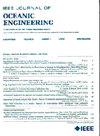基于智能降噪的Hilbert-Huang变换被动声纳信号处理
IF 5.3
2区 工程技术
Q1 ENGINEERING, CIVIL
引用次数: 0
摘要
海洋科学在海洋勘探中发挥着关键作用,鼓励开发新的水下声波分析方法。在用于军用船只探测和分类的被动声纳探测和测距(SONAR)信号处理中,最主要的技术是短时傅里叶变换(STFT)。然而,这种频谱分析方法存在时频(TF)分辨率的限制,影响了特征提取和船只动态行为监测的性能。希尔伯特-黄变换(HHT)是 STFT 的替代方法,可提供高分辨率的数据驱动 TF 分析。然而,在标准的 HHT 算法中,估计精度会随着噪声的增加而降低。本文提出了一种新的 HHT 算法,即通过智能除噪计算 HHT(HHT-INR)。所提出的方法主要针对被动声纳监控应用,其中所关注的信息通常包括由船舶机械和螺旋桨系统产生的不同正弦分量。在 EMD 估计过程中,一个基于支持向量机的智能系统会检测并去除噪声 IMF。模拟和实验无源 SONAR 信号的结果表明,其性能优于基于 STFT 的分析。HHT-INR 降低了背景噪声,提高了分析时变情况下船只参数的分辨率。所提出的方法大大提高了实验信号的频率分辨率,使频谱宽度平均降低了约 28.5 倍。此外,信噪比平均提高了 87.9 dB。本文章由计算机程序翻译,如有差异,请以英文原文为准。
Hilbert–Huang Transform With Intelligent Noise Reduction for Passive SONAR Signal Processing
Ocean science plays a key role in marine exploration, encouraging the development of new methods for analyzing underwater acoustic waves. In passive SOund NAvigation and Ranging (SONAR) signal processing for military vessel detection and classification, the predominant technique is the short-time Fourier transform (STFT). However, this spectral analysis method has time–frequency (TF) resolution limitations, impacting performance in feature extraction and vessel dynamic behavior monitoring. The Hilbert–Huang transform (HHT) is an alternative to STFT, providing a data-driven TF analysis with high resolution. However, in standard HHT algorithms, estimation accuracy degrades as noise increases. This article presents a novel algorithm for HHT that computes the HHT with intelligent noise removal (HHT-INR). The proposed method is focused on passive SONAR surveillance applications, in which the information of interest usually comprises different sinusoidal components produced by the vessels' machinery and propeller system. An intelligent system based on support vector machine detects and removes noisy IMF during the EMD estimation process. Results with simulated and experimental passive SONAR signals indicate better performance than the STFT-based analysis. The HHT-INR reduces background noise and enhances resolution for analyzing vessel parameters in time-varying scenarios. The proposed method significantly improved frequency resolution in experimental signals, achieving an average reduction in spectral width of approximately 28.5 times. In addition, there was an average increase of 87.9 dB in the signal-to-noise ratio.
求助全文
通过发布文献求助,成功后即可免费获取论文全文。
去求助
来源期刊

IEEE Journal of Oceanic Engineering
工程技术-工程:大洋
CiteScore
9.60
自引率
12.20%
发文量
86
审稿时长
12 months
期刊介绍:
The IEEE Journal of Oceanic Engineering (ISSN 0364-9059) is the online-only quarterly publication of the IEEE Oceanic Engineering Society (IEEE OES). The scope of the Journal is the field of interest of the IEEE OES, which encompasses all aspects of science, engineering, and technology that address research, development, and operations pertaining to all bodies of water. This includes the creation of new capabilities and technologies from concept design through prototypes, testing, and operational systems to sense, explore, understand, develop, use, and responsibly manage natural resources.
 求助内容:
求助内容: 应助结果提醒方式:
应助结果提醒方式:


